I am dedicating this special Earth Day BookNotes to a long review of one new book, one that we are particularly excited about, for a variety of reasons, as you will see.
We’ve done other lists of ecological books, and we suggest revisiting those BookNotes columns and lists that are important to us, HERE, HERE, or this long and somewhat dated essay about, among other things, being disappointed by Kurt Vonnegut and living near Three Mile Island, HERE. Some of the books mentioned in passing may not even be in print anymore, and the prices are surely different, but many from these three BookNotes are easily available. I hope you enjoy my reflections. Thanks for caring.
Other than this big brand new one I’m reviewing today, I’d also most eagerly recommend these four fabulous books offering foundations for a Biblically Christian view of creation care; interestingly, the authors of which admire the work of the Gail Gunst Heffner and David Warners, who wrote the book that today’s book review explores. We’ve highlighted these others before so I won’t say much but had to highlight them as they are so good. The fourth one listed, published by Calvin College Press, is one where the authors of today’s book appear, as well. They obviously have a lot to offer.
TO ORDER FROM US HERE AT HEARTS & MINDS, JUST SCROLL TO THE BOTTOM AND CLICK ON THE ORDER PAGE LINK WHERE YOU CAN SECURELY SHARE NECESSARY INFORMATION. WE’LL PROMPTLY CONFIRM AND SEND YOUR ORDER OUT WITH A SMILE AND A PRAYER. ALL BOOKS MENTIONED ARE 20% OFF.
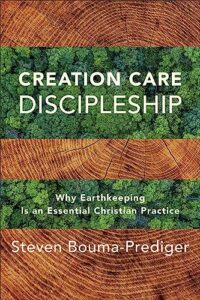 Creation Care Discipleship: Why Earthkeeping Is an Essential Christian Practice by Steven Bouma-Prediger (Baker Academic) $25.99 OUR SALE PRICE = $20.79
Creation Care Discipleship: Why Earthkeeping Is an Essential Christian Practice by Steven Bouma-Prediger (Baker Academic) $25.99 OUR SALE PRICE = $20.79
I’ve raved about Steven’s previous works from his classic For the Beauty of the Earth to the fabulous Earthkeeping and Character: Exploring a Christian Ecological Virtue Ethic. This recent one is smart and not at all simplistic, but really foundational, if you will. Everybody should read this. It’s a must, showing how creation-care should be an ordinary part of faithful discipleship.
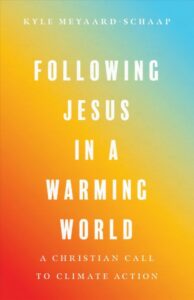 Following Jesus in a Warming World: A Christian Call to Climate Action by Kyle Meyaard-Schaap (IVP) $18.00 OUR SALE PRICE = $14.40
Following Jesus in a Warming World: A Christian Call to Climate Action by Kyle Meyaard-Schaap (IVP) $18.00 OUR SALE PRICE = $14.40
Kyle Meyaard Schaap is one of these fabulously passionate, delightful young leaders who is good at Bible teaching, theology, storytelling, knowing theoretical insights and offering down-to-earth practical guidance about faithful steps. Richard Mouw calls it “marvelously engaging.” Highly recommended.
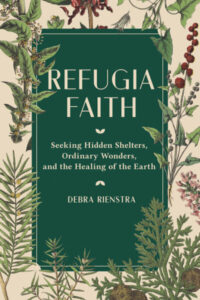 Refugia Faith:Seeking Hidden Shelters, Ordinary Wonders, and the Healing of the Earth by Debra Rienstra (Fortress Press) $23.99 OUR SALE PRICE = $19.19
Refugia Faith:Seeking Hidden Shelters, Ordinary Wonders, and the Healing of the Earth by Debra Rienstra (Fortress Press) $23.99 OUR SALE PRICE = $19.19
This hardback is one of the most moving, graciously written, glorious book about eco-care that we know of. It explores with faith-informed glory all about caring for the Earth. Debra is cited by the book below as she should be (but she does teach with the authors at Calvin University in Grand Rapids.) This is one of the best books I’ve read in recent years, and it repays multiple reads. Truly lovely even as it makes you re-think much.
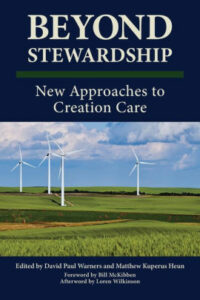 Beyond Stewardship: New Approaches to Creation Care edited by David P. Warners and Matthew Kuperus Huen (Calvin College Press) $17.99 OUR SALE PRICE = $14.39
Beyond Stewardship: New Approaches to Creation Care edited by David P. Warners and Matthew Kuperus Huen (Calvin College Press) $17.99 OUR SALE PRICE = $14.39
I’ve explained this amazing collection of essays before and, curiously, all three of the above mentioned authors have chapters included. It should be better known, I’d think — there is a lovely, good foreword by Bill McKibben and an important afterword by Loren Wilkinson. Although the book is not overly heady or academic, it is audacious in many ways: it invites us to ponder whether the paradigm of “stewardship” of creation it itself a helpful way to think about our relationships with other creatures in God’s world. Maybe not, they say, in many ways, from many angles. There’s a lot in this rare volume and I find myself coming back to it for time to time. It would make a fantastic study book for those wanting to dig deeply into the subject. Here’s a fun bit of extra stuff designed for those wanting some visual aids in reading. And there is a podcast with a lively interview with each author of the chapter’s of the book. Hooray. What a good book this is!
+++
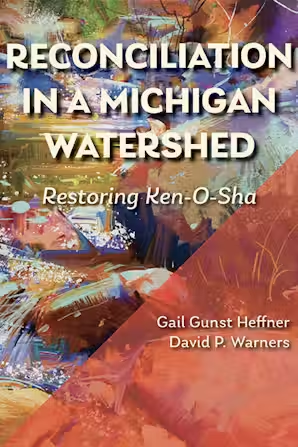 Reconciliation in a Michigan Watershed: Restoring Ken-O-Sha Gail Gunst Heffner & David P. Warners (Michigan State University Press) $29.95 OUR SALE PRICE = $23.96
Reconciliation in a Michigan Watershed: Restoring Ken-O-Sha Gail Gunst Heffner & David P. Warners (Michigan State University Press) $29.95 OUR SALE PRICE = $23.96
While on a panel at Calvin University’s Festival of Faith & Writing a week or so ago, I was asked, while sitting next to the wonderful Anne Bogel and Karen Swallow Prior, by our conversation partner, Jennifer Holberg, what books these days have brought me joy.
I rattled off a handful of fun, recent reads, books I’ve delighted in, either because they were a touch silly (like the great, smart novel by Bob Hudson, The Beautiful Madness of Martin Bonham telling the wild fiction of starting a college department about the love of God and how a local seminary objected) or just because they were so very well-written (Beth and I simply adored Lost and Found: Reflections on Grief, Gratitude, and Happiness by esteemed writer Kathryn Schulz) or that were truly funny, if dark, such as the most recent by a fabulous author Harrison Scott Key (How to Stay Married: The Most Insane Love Story Ever Told.) I could have mentioned Jennifer’s own book, Nourishing Narratives: The Power of Story to Shape our Faith which is a book-lover’s dream and promises great delight for those that value reading and stories.
One that I mentioned is not intentionally funny or overly joyful, even, but it has brought more delight than anything I’ve had in my hands in ages.
This is one I’ve been waiting for.
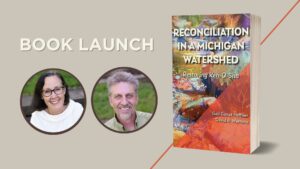
Reconciliation in a Michigan Watershed: Restoring Ken-O-Sha by Gail Gunst Heffner and David P. Warners is a book of hope, telling a remarkable story with great care and nuance, teaching, preaching, exploring, and documenting a decades-long, brave, hard, journey into reconciliation ecology as it informs the cleaning up and care of a creek that runs through the city and regions around Grand Rapids, Michigan. Reconciliation in a Michigan Watershed tells of the restorative work of many community partners organized through teams at Calvin College (now University) and their Office of Community Engagement.
It is a story I want to celebrate now — here in this special Earth Day edition of BookNotes — because it is stunningly important and exemplary (as we shall see) but also because it is a long labor of love by two dear friends of ours. One of the authors, Gail Gunst Heffner, is one of our best and oldest friends in the world (who helped us launch our store in the early 1980s.) You should know we want to be a champion for her extraordinary work.
 Gail has a PhD in urban studies and used her graciously outgoing personality to expertly serve the greater Grand Rapids area by harnessing the social capital and resources (and sometimes, sheer person-power) of Calvin College, finding ways to partner with agencies doing good work in the area. From racial justice topics to housing and public health concerns to big ecological issues, she served the Provost of the college by building neighborhood networks, serving on the Boards of nonprofits, writing grants, meeting with church, community, and civic groups, listening well so as to help the college learn what the city might need of it. I don’t know if other colleges have such an “Office of Social Engagement” but Gail has done remarkable work in this important role.
Gail has a PhD in urban studies and used her graciously outgoing personality to expertly serve the greater Grand Rapids area by harnessing the social capital and resources (and sometimes, sheer person-power) of Calvin College, finding ways to partner with agencies doing good work in the area. From racial justice topics to housing and public health concerns to big ecological issues, she served the Provost of the college by building neighborhood networks, serving on the Boards of nonprofits, writing grants, meeting with church, community, and civic groups, listening well so as to help the college learn what the city might need of it. I don’t know if other colleges have such an “Office of Social Engagement” but Gail has done remarkable work in this important role.
Her previous work for the college on academic-based service learning (twenty-some years ago she co-edited a ground-breaking book called Commitment and Connection: Service-Learning and Christian Higher Education) already had cache as Calvin became recognized as one of the best examples of such academic-based service learning, department by department, helping students learn well by serving the community in particular ways, suited to their disciplines. That Gail and some of her colleagues from the service-learning world were asked to offer guidance to institutions of higher learning in the aftermath of the dismantling of apartheid in South Africa indicates her mature leadership in discerning and living into God-honoring initiatives of transformational social change.
And so the Plaster Creek Stewards came into being and was one of the many projects Gail (co)-organized and managed. Many Calvin colleagues — from the hard sciences to oral historians to computer science techies and more — joined the movement to recruit folks to clean up Plaster Creek, then considered one of the most polluted waterways in Western Michigan. We have followed her leadership on this from afar for more than a decade and have prayed for this book’s pages for years. What a joy to now hold it. And to tell you about it.
The other author of Reconciliation in a Michigan Watershed, David Warners, is a brilliant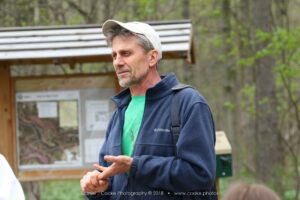 scientist (with a specialty in botany), a scholar of creation care theology, and an excellent, beloved Calvin biology professor. He co-founded the Plaster Creek Stewards and took up the cause of stewarding Plaster Creek with whole classes of eager students, realizing early on that simple riverside restoration is incredibly complex. History, as they say, is messy, and such ecological projects are, like most everything else, rooted in history.
scientist (with a specialty in botany), a scholar of creation care theology, and an excellent, beloved Calvin biology professor. He co-founded the Plaster Creek Stewards and took up the cause of stewarding Plaster Creek with whole classes of eager students, realizing early on that simple riverside restoration is incredibly complex. History, as they say, is messy, and such ecological projects are, like most everything else, rooted in history.
Gail understood better than most some of the deeper implications of the study of environmental racism (see her chapter on this in Beyond Stewardship: New Approaches to 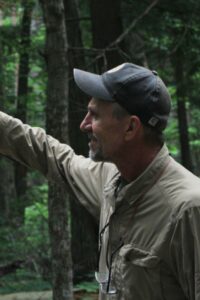 Creation Care called “Making Visible the Invisible”, mentioned above) while Dave knew well the exceedingly detailed webs of ecological complexity; together they and their teams started to share with those living in the watershed stuff about healing the degradation, reparations such as bioswales and rain gardens; they researched and warned about the dangerously high E-coli levels in the water, and why industrial pollution and agricultural run-off (that is, fertilizer from farms and lawns) upstream simply must be understood as it damages everything downstream. What does it mean to love your downstream neighbor, they asked. It’s an important question for all of us, since we are all situated in watersheds.
Creation Care called “Making Visible the Invisible”, mentioned above) while Dave knew well the exceedingly detailed webs of ecological complexity; together they and their teams started to share with those living in the watershed stuff about healing the degradation, reparations such as bioswales and rain gardens; they researched and warned about the dangerously high E-coli levels in the water, and why industrial pollution and agricultural run-off (that is, fertilizer from farms and lawns) upstream simply must be understood as it damages everything downstream. What does it mean to love your downstream neighbor, they asked. It’s an important question for all of us, since we are all situated in watersheds.
(Did you know there is a sub-science and movement of those helping care for urban waterways, coping not only with rainwater flash floods and sewer drains and underground streams and such, but urban wastewater and more? It is not a major part of this book, but you will learn a bit about this little understood scene; Plaster Creek is, largely an urban watershed.)
To start even small projects of river restoration one can clear brush and replant native plants and do any number of simple gestures of inhabiting a watershed in healthy ways. But, again, the bigger questions, as Reconciliation in A Michigan Watershed so painstakingly shows, have to do with how early European settlers understood water and their practices of managing it in certain ways, the rise of industrialization and urbanization and ways storm run-off and sewage treatment plants work. It has to do with agricultural policies and factory farms (and, yes, other sorts of factories that even in our day and age dump chemicals into creeks and rivers.) Plaster Creek Stewards very quickly became much more than happy college kids volunteering to clean up waterside litter or plant some lovely native flowers. They faced what we sometimes call structural and systemic matters, and questions of who gets a voice (“a seat at the table” as they say) and who calls the shots becomes urgent. They tell the story with flare; it is a bit unclear if they realized, starting the project so many years ago, what all they were getting themselves into!
I will never forget as long as I live the exact place Beth and I were — in our van while returning home from an out-of-state trip — when Gail called us to ask for immediate prayers. Their ongoing work in community development and grass-roots organizing led to sometimes contentious community meetings, town hall forums, civic gatherings, and zoning debates in boroughs and townships around Grand Rapids about policies and protocols. As the book tells — it’s a page-turner but not overly flamboyant — they had just received bomb threats!
Was it from industrial scale farmers? Racist opposition from anti-indigenous people movements? Fancy but ill-informed suburbanites who thought native plants would hurt their little near-by park? I’m paraphrasing here, but you can imagine the sorts of people that get up in arms (in this case, literally) when college activists, no matter how gracious and willing to listen, start talking green. One person got into the faces of our friends and spit out that they don’t trust academics and they don’t trust scientists. David and Gail are among the nicest people on the planet, and I wish the book told even more about how they felt and handled these egregious opponents, some most likely packing heat, as they tried to help restore this messy, abused waterway.
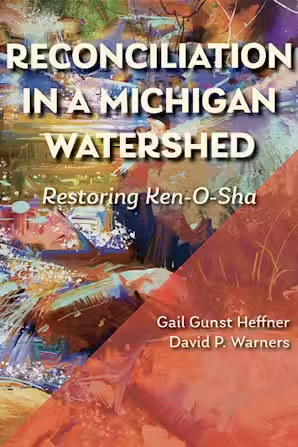 Reconciliation in a Michigan Watershed: Restoring Ken-O-Sha has as its subtitle the indigenous people’s name for what the European settlers re-named Plaster Creek, and this is a very important aspect of the book. David and Gail learned early on that to truly understand the devastation of the watershed — that had been cared for wisely for centuries by the Hopewell people, the Anishinaabeg clans, and then what the French called the Ottawa — they would have to learn from and partner with Native peoples.
Reconciliation in a Michigan Watershed: Restoring Ken-O-Sha has as its subtitle the indigenous people’s name for what the European settlers re-named Plaster Creek, and this is a very important aspect of the book. David and Gail learned early on that to truly understand the devastation of the watershed — that had been cared for wisely for centuries by the Hopewell people, the Anishinaabeg clans, and then what the French called the Ottawa — they would have to learn from and partner with Native peoples.
The chapters about the history of 18th and 19th century friendships and broken treaties, forced removals and residential schools, and all the rest of the devolving of peaceful, cross-cultural relationships, are captivating and compelling and tragic. Their accounts of visiting local burial mounds (most were destroyed by those forming the city of Grand Rapids, even as they drained the landscape starting in the mid-1800s) is very moving and their respectful citations of Native sources is fabulous.
For anyone who has been reading First Nations stuff (or learning about the Doctrine of Discovery) this will be good to take up after, say, The Land is Not Empty: Following Jesus in Dismantling the Doctrine of Discovery by Sarah Augustine (Herald Press) or Mark Charles & Soong-Chan Rah’s Unsettling Truths: The Ongoing, Dehumanizing Legacy of the Doctrine of Discovery (IVP.) I think Randy Woodley’s Shalom and the Community of Creation: An Indigenous Vision (Eerdmans) is essential reading, here, and would be a good companion volume to pair with Reconciliation… In fact, with their good section comparing worldviews and the assumption different worldview communities bring to their engagement with the natural world, and water, particularly, they might have cited his Indigenous Theology and the Western Worldview: A Decolonized Approach to Christian Doctrine (Baker Academic) Woodley is a respected Cherokee teacher, missiologist, and historian who brings a good word for any of us who think about these things.
Those of us not from the Great Lakes regions, I think, have much to learn from this quick but solid overview. We may know about the Appalachian Trail of Tears or the storied Plains Indians or the great struggles of the Sioux against Custer and the like; we are eager to learn about the lively cities in the American Southwestern deserts but for some of us, the Hurons and Ottawas are less known, I suspect. I might want to give a shout-out to last year’s National Book Award Winner The Rediscovery of America: Native Peoples and the Unmaking of U.S. History by Ned Blackhawk, published by Yale University Press, but Reconciliation in a Michigan Watershed nicely does some of the heavy lifting for those wanting a glimpse of the history of Native Peoples and their encounters with the influx of Europeans into their homelands. To be clear, Heffner & Warners want to learn from the worldview of those who once lived in the watershed area not only as a justice issue but also for practical reasons: the Ottawa seemed to know a thing or two about rivers, fishing, farming, developing culture, housing, and watershed care long before we coined the phrase “sustainability.” Could we, even now, learn from local Native people? This book tells some stories and offers some good guidance, an aspect of the watershed restoration project that I had not quite expected. If you liked the beautiful, powerful Braiding Sweetgrass: Indigenous Wisdom, Scientific Knowledge and the Teachings of Plants by Robin Wall Kimmerer [Milkweed Editions] you’ll appreciate their efforts, I’m sure. Kudos!
In any case, Heffner & Warner’s eagerness to integrate the history of Native peoples and honor their capacity to live well within the watershed is a great value of the book. How great it is that a major blurb on the back cover is from Ron Yob, Chairman of the Grand River Bands of Ottawa Indians, who found it “extremely interesting.” He is right in saying that it is “written for the benefit of all living creation.” And non-living creatures, too, all of which, as these Reformed Christians so deeply understand, praise their Maker and give glory to God.
There are three units or parts of Reconciliation… that frame the telling of this story that unfolded year after year in Grand Rapids. The first they call “Discovered Ignorance” which is how they came to recognize the depths of the problem From some of Ken-O-Sha’s geologic past to the Plaster Creek watershed today, they explore the native peoples that once cared well for the river known (then, as the name, translated, indicates) for plentiful Walleyes.
And they tell how pollution was an early feature of white European colonial impact — missionaries and pioneers and those running trading outposts discovered gypsum along the banks of the Ken-O-Sha and they mined it fiercely, creating buildings and barges and railways to send the cheap fertilizer as far away as San Francisco. Coupled with the notoriously savage clear cutting of old-growth forests for the lumber barons — Grand Rapids still is considered one of the fine centers of the furniture industry — the stewardly care for the ecology of Western Michigan has been a disaster. Such disregard for creation came to a symbolic head when the Cuyahoga River in Cleveland (just a bit south) caught fire in 1969! Of course, the polluted river had caught fire plenty of times before that and it was legendary in those parts, south of Lake Erie, the lake into which it flows. Ken-O-Sha, or Plaster Creek, flows directly into the Grand River, which not far away flows into the beautiful, but troubled, Lake Michigan. This, frankly, is part of the story of most of our regions and it is good to see how these authors invite us not to guilt but to honesty about our past and possibly present complicity in ecological brokenness.
After two chapters on naming the problems, the important Part 2 “acknowledges our complicity” by teaching us more about the interactions between the Ottawa and European immigrants, the fascinating development of European settlement in West Michigan and what they’ve learned from careful archival study about the impact upon Plaster Creek. There have been violent episodes in the harsh periods of colonization and too often attitudes of white, Christian, supremacy (that are seen yet today.) Their section called “Worldview Contrasts and Ecological Fallout” is a tremendous case study in how various groups perceive and engage in the world around them and what those with a more modernist worldview might learn from indigenous wisdom.
As social and natural scientists informed by what some might call a neo-Calvinist or even somewhat Kuyperian sort of world-and-life orientation — Calvin University is known for its legacy of “thinking Christianly” as they integrate faith and scholarship — these author’s insights into the influences of world-and-life social imaginaries is delightfully evident; that a book on a major, scholarly publishing house like Michigan State University Press includes footnotes from the likes of James Sire, for instance, is notable. Naturally, our authors are fluent with many of our best eco-thinkers and writers, from Wendell Berry to David Orr, from Fred Bahnson and Norman Wirzba to Gretel Van Wieren, and the important Doreceta Taylor and the inspiring Richard Louv. It isn’t every day we see citations from Ched Myers’s edited volume, Watershed Discipleship: Reinhabiting Bioregional Faith and Practice but, obviously, it is important for them. You want “ecological literacy”? Dave can tell you the names of hundreds of plants and they both know the best books and authors which makes reading this a learned delight. Hooray!)
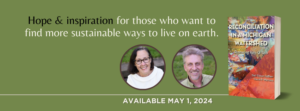
The biggest part of this 280 page book is Part 3, “The New Story of Plaster Creek: Committing to Restoration and Reparations” which is not only a history of their multi-pronged approach but nearly a handbook for social change organizers anywhere. What a delight learning how they wrote grants, organized work crews, evoked artists and poets, partnered with civic leaders, faith leaders, science writers, municipal officials. How diligent, playful, and (often) effective they have been. What a joy — I’m not just saying this! — to be caught up in the energy of living out hopes and dreams, experiencing frustrations and set-backs, learning and teaching, building networks and finding new ways to engage others in caring for ecological responsibility in the local watershed. They tell of working with schools and civic groups, with children and youth, and, obviously, with churches. Interestingly, in one page-turning part that built momentum, they are invited to speak at a local mosque, helping Muslim congregants do their part in caring for the environment. (And there is always the very real, human touch: they admit how Dave thought he was supposed to take his shoes off when entering the mosque, until he realized, later, he was the only one in sock feet. Ha!)
This last third of the book is thrilling, I’d say, and, as many books as I have read about environmental care, Biblical earthkeeping, stewardship, and the like, I have never quite pieced together quite so much about the incredible significance of watersheds and bioregions. (We live near the mighty Susquehanna, that flows into the Chesapeake, by the way, and there is good, good work going on in our area with The Lower Susquehanna Riverkeeper Association, The Watershed Alliance of York, etc.) Reconciliation in a Michigan Watershed is, obviously, a Great Lakes story, but, frankly, it could be easily adapted and used anywhere; it serves as a way to not only motivate and challenge but guide us all into being River Keepers. If you think this is something your not interested in, I’d invite you to prayerfully give it a go — who knows, it might stir something. Who doesn’t value clean water and lovely streams and rivers?
There are colorful chapters on “developing engaged citizens through place-based education” and how to “asses the problems with applied research.” You will be delighted by their stories of “reconciling the human-nature relationship through on-the-ground restoration.” I learned the phrase “green infrastructure” by which they mean various sorts of low-impact development plans to enhance local ecosystems and “rainscaping” like vegetated buffers, channels, rain gardens, bioswales and such.
I mentioned that Gail has already written (a chapter called “Making the Visible Invisible”) on environmental racism and the structures and cultural habits that tend to put people of color at greater risk from toxic sludge and the like, so it is no surprise that this comes up in their fight for Plaster Creek / Ken-O-Sha. They have a section called “Loving Our Downstream Neighbors — a Call for Environmental Justice” which is informed and at times, dramatic.
How local congregations have taken up their call to public justice and cared well for their own facilities is a lovely part of the chapter on engaging faith communities. They tell a variety of stories (including a neat partnership with the National Wildlife Federation and their Sacred Grounds programs resourcing local congregations learn to plant and steward native plantings.
Ahh, and it isn’t always easy — they tell in the book about the EPA calling them asking them to create plans to educate churches upstream about the detriment of dumping farming wastes into the creek; when the feds call the local Christians saying that the polluters “… won’t listen to us but maybe they’ll listen to you”, you know it is a fascinating — and urgent — story!
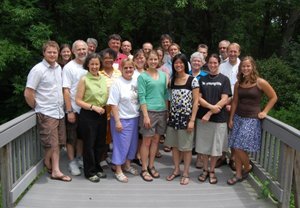 (And, let’s face it — I suspect most of us don’t have freinds who end up with their smiling pictures on the EPA website, congratulating them on their hard work. Reading this book will help you understand why. Hooray.)
(And, let’s face it — I suspect most of us don’t have freinds who end up with their smiling pictures on the EPA website, congratulating them on their hard work. Reading this book will help you understand why. Hooray.)
Some of you will love the chapter about raising up young ecological leaders — watch the inspiring Youtube video from the website Plaster Creek Steward showing highschool kids doing good work, trained by PCS. All will be inspired by the last piece, entitled “An Invitation to the Work of Reconciliation Ecology Everywhere.” Wow.
Two other quick notes about the book:
One of the ways David and Gail got academic colleagues and students involved was recruiting some to do oral histories of those who once lived near, or still do live within, the Plaster Creek Watershed. The Plaster Creek Oral History Project has not only been charming and interesting but really, really important. These first-hand accounts of the memories of the creek of older folks, the stories of post-WW II neighborhoods and their relationship with the streams and watershed, the stories of modern-day, local, urban kids or contemporary testimony of regional farmers, all make the book come alive. You will not want to miss a single one of these fascinating transcriptions of ordinary folks (some quite unaware of the dangers of chemical pollutants, say, and others who were very involved in working for cleaner waterways.) From stormwater run-off specialists to those working in the sewage-treatment industry, from the mayor’s office to ordinary folk who played and fished in the stream, these first hand stories are magnificent and occasionally quite arresting. This brings the book context and texture — even when the conversation partners called it a “crick.” I get that!
Also, and importantly, their language of reconciliation ecology is somewhat unique, but may be the vanguard of new and faithful ways to describe our projects of the future. They insist that God desires reconciliation between estranged people groups and between people and the creation itself. The interface of peacemaking and justice work between races, genders, and other conflicted groups with the disorientation we all experience when not in harmony with the creation itself is the nexus (they might say) of their gospel work.
That this vision is underpinned by their deep, serious, convictions about Christ’s redemptive arc and the creation-wide scope of Kingdom restoration should be evident, but the work, somewhat funded by Calvin University and inspired by their own life as disciples of the Lord of creation, fundamentally Christian as it may be, isn’t the focus of the book. In plain language, it bears witness to their faith and talks about congregations and worldviews, but it doesn’t feel like a “Christian” book, let alone a theological treatise. It is, of course, shaped and informed by their own wholistic Christian worldview, but it can easily be read by one and all as it is for the general public. In fact, that is one of the great genius points of this profound study — it is for the reading public, to mobilize ordinary folks, for the sake of the world.
This book deserves a wide readership, in part because it is so well told. And it does hope to inspire action; in that sense it has an agenda. It wants to serve the creation that is both glorious and groaning. The first line in the first page of the preface of Reconciliation in a Michigan Watershed notes, “We live in a world of beauty and of wounds.” After a few sentences, they say, “This book tells a story of splendor and provision while also revealing a story of disorder and degradation.”
This is the sort of book that we need more of — thoughtful, Christianly done, but with faith more between the lines, happily accessible to readers of various philosophical views, working out a Christian worldview for the sake of this world of “beauty and of wounds.” I am honored to tell you about it. Beth and I hope many purchase it and commit to working through it over this next season or so. I’m sure you will learn a lot. Maybe, just maybe, it will inspire us all to be agents of God’s reconciling work, even into our own unique places, embedded as we are, in our own particular watersheds.
“A fascinating and moving tale, and a fascinating and powerful book. Reconciliation ecology is a discipline we badly need, and its motto could well be “Unhealthy water reveals unhealthy relationships.” — Bill McKibben, author The Flag, the Cross, and the Station Wagon
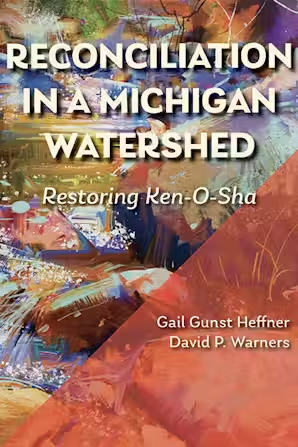
+++
TO PLACE AN ORDER
PLEASE READ, THEN SCROLL DOWN AND CLICK ON THE “ORDER HERE” LINK BELOW.
It is helpful if you tell us how you want us to ship your orders. And if you are doing a pre-order, tell us if you want us to hold other books until the pre-order comes, or send some now, and others later… we’re eager to serve you in a way that you prefer. Let us know your hopes.
The weight and destination of your package varies but you can use this as a quick, general guide:
There are generally two kinds of US Mail options and, of course, UPS. If necessary, we can do overnight and other expedited methods, too. Just ask.
- United States Postal Service has the option called “Media Mail” which is cheapest but can be a little slower. For one typical book, usually, it’s $4.33; 2 lbs would be $5.07. This is the cheapest method available and seems not to be too delayed.
- United States Postal Service has another, quicker option called “Priority Mail” which is $8.70, if it fits in a flat-rate envelope. Many children’s books and some Bibles are oversized so that might take the next size up which is $9.50. “Priority Mail” gets much more attention than does “Media Mail” and is often just a few days to anywhere in the US.
- UPS Ground is reliable but varies by weight and distance and may take longer than USPS. Sometimes they are cheaper than Priority. We’re happy to figure out your options for you once we know what you want.
If you just want to say “cheapest” that is fine. If you are eager and don’t want the slowest method, do say so. It really helps us serve you well so let us know. Keep in mind the possibility of holiday supply chain issues and slower delivery… still, we’re excited to serve you.
BookNotes
SPECIAL
DISCOUNT
20% OFF
ALL BOOKS MENTIONED
+++
order here
this takes you to the secure Hearts & Minds order form page
just tell us what you want to order
inquire here
if you have questions or need more information
just ask us what you want to know
Hearts & Minds 234 East Main Street Dallastown PA 17313
read@heartsandmindsbooks.com
717-246-3333
Sadly, as of April 2024 we are still closed for in-store browsing. COVID is not fully over. Since few are reporting their illnesses anymore, it is tricky to know the reality but the best measurement is to check the waste water tables to see the amount of virus in the eco-system. It isn’t good. It is important to be aware of how risks we take might effect the public good — those at risk, while not dying from the virus, are experiencing long-term health consequences. (Just check the latest reports of the rise of heart attacks and diabetes among younger adults, caused by long Covid.) It is complicated, but we are still closed for in-store browsing due to our commitment to public health (and the safety of our family who live here, our staff, and customers.) Our store is a bit cramped without top-notch ventilation, so we are trying to be wise. Thanks very much for understanding.
We will keep you posted about our future plans… we are eager to reopen. Pray for us.
We are doing our curb-side and back yard customer service and can show any number of items to you if you call us from our back parking lot. It’s sort of fun, actually. We are eager to serve and grateful for your patience as we all work to mitigate the pandemic. We are very happy to help, so if you are in the area, do stop by. We love to see friends and customers.
We are happy to ship books anywhere.
We are here 10:00 – 6:00 EST / Monday – Saturday. Closed on Sunday.

